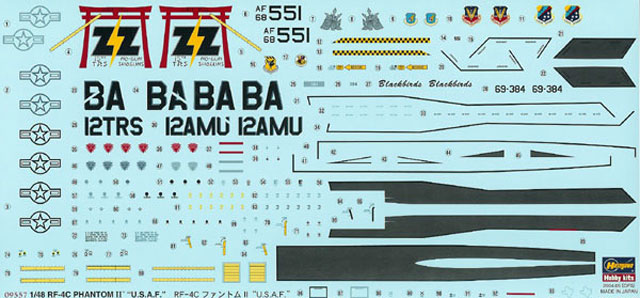|
RF-4C Phantom II
“U.S.A.F”

Hasegawa 1/48
S
u m m a r y
|
| Catalogue Number
and Description: |
09557 |
| Scale: |
1/48 |
| Price: |
3200 Yen (Japan) |
| Contents and Media |
Injection molded plastic |
| Review Type: |
FirstLook |
| Advantages: |
Both camera noses included |
| Disadvantages: |
Numerous instruction sheet errors |
| Recommendation: |
Recommended |

HyperScale is proudly supported by Squadron
Reviewed by Dave
Williams
Ever since Hasegawa released their RF-4E kit (kit PT 30) earlier this year, many
have been wondering if the kit could be made into a RF-4C. These questions
continued with the subsequent RF-4B release (kit PT 31). The answer was that
both kits would need some modification to make a RF-4C. The RF-4E kit had –Kai
wings, with different wingtip antennas, and lacked the short burner cans. The
RF-4B kit was much closer, but only had the slotted stab. Now, the waiting is
over as Hasegawa has finally released their kit as a RF-4C version.
Perhaps somewhat unsurprisingly given how Hasegawa stretch their molds, the kit
is basically the RF-4B kit, which was for one of the last few RF-4Bs that has
the thick wing like the RF-4C/E, with non-slotted stabs instead of the slotted
stabs. Carried over from the RF-4B kit are new instrument panels and new-tool
short burner cans (the latter unused in the RF-4B kit). Also, you get both the
flat and round camera noses. Unfortunately, you only get the original centerline
tank in the kit and the high-speed F-15-style tank as included in the RF-4E kit
is omitted. Similarly, the chaff/flare dispensers that go on the rear of the
inboard pylons, which again were in the RF-4E kit, are also omitted in this
boxing.
Although it looks like all of the correct parts are physically in the kit,
Hasegawa has made a number of errors in their instruction sheet. First of all,
the instructions have you add the quilted right sidewall to the rear cockpit as
in the RF-4B kit. This panel is unique to the Navy and British version of the
F-4 as the refueling probe was mounted on the other side, and should be left off
for the –C version. In addition, the instruction omit telling the modeler to
fill in the unused panel lines for the Navy-style refueling door on the side of
the fuselage (the RF-4 fuselage comes with panel lines for both USAF and USN
types scribed into the plastic – the “unused” lines are meant to be filled in).
The wing is the hard wing from the –J kit and, although the instructions
correctly show the removal of various bumps from the top and bottom of the wing,
they still have one add the insert panels with the catapult hooks on the wing
underside. Fortunately, the correct non-hook inserts (parts L8 and L9) are on
the sprue and should be used instead. Finally, although Hasegawa includes some
nice new-tool short burner cans (parts T3 and T4), the instructions inexplicitly
mark them as “not for use” and they tell you to use the long cans as in the
RF-4E kit. To my knowledge, USAF RF-4Cs were not refitted with the longer burner
cans as fitted to later F-4 versions, and the box photo of one of the marking
options clearly shows the aircraft with the short cans.
Decals are included for two aircraft. The first is from the 15th TRS 18th TFW
PACAF in Euro One camouflage with special “Shogun” markings. The alternate
option is for an aircraft from the 12th TRS 67th TRW from Bergstrom AFB in the
Hill Gray scheme.

These are Hasegawa decals, although in running my finger over them, they seem
a little thinner than the usual thick kit decals and will probably work
satisfactorily out of the box. In a continuation of the instruction sheet
problems, the instructions have you build the PACAF aircraft with the flat nose,
while the box photo of the real thing shows this aircraft fitted with the round
nose.
Overall, this is a good kit that we have waited for a long time, but it is a
little disappointing that the instruction sheet contains so many errors that
should have been picked up earlier, IMHO.
Note that this kit is one of Hasegawa’s gold-bordered “limited” boxings, but
it isn’t clear if the “limited” relates to the RF-4C version, or just the
specific decals in the kit.
Recommended.
Sample courtesy of my ever dwindling bank account.
Dave Williams
IPMS/USA 19050
Review Copyright © 2004 by Dave
Williams
Page Created 01 June, 2004
Last updated 01 June, 2004
Back to HyperScale
Main Page
Back to Reviews
Page
|
Home | What's
New | Features
| Gallery |
Reviews | Reference
| Forum
| Search